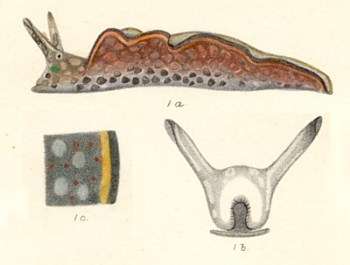
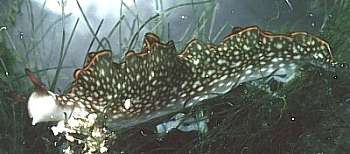
Elysia rufescens
(Pease, 1871)
Order: SACOGLOSSA
Superfamily: ELYSIOIDEA
Family: Elysiidae
DISTRIBUTION
Known from Tahiti, Hawaii, Guam.
PHOTO
UPPER: Original illustrations from Pease, 1871, Pl. 22. Paintings by Andrew Garrett.
LOWER: 60mm long, reef flat, Pago Bay, Guam, 13 July 1984 on Bryopsis pennata. PHOTO: C. Carlson & P.J.Hoff.
Published records from Tahiti (original description) and from Hawaii (Kay, 1979). See also Carlson & Hoff's message below. See messages below suggesting that E. kushimotoensis is a synonym of E. rufescens.
References:
• Baba, K (1957) The species of the genus Elysia from Japan. Publications of the Seto Marine Biological Laboratory, 6: 69-74.
• Kay, E.A. (1979) Hawaiian Marine Shells Bishop Museum Special Publication 64(4). Bishop Museum Press: Honolulu. p454.
• Pease, W.H. (1871). Descriptions of Nudibranchiate Mollusca inhabiting Polynesia. American Journal of Conchology, 6(4): 299-305.
Rudman, W.B., 1999 (August 9) Elysia rufescens (Pease, 1871). [In] Sea Slug Forum. Australian Museum, Sydney. Available from http://www.seaslugforum.net/find/elysrufe
Related messages
Elysia rufescens feeding
June 18, 2007
From: Hugues Flodrops
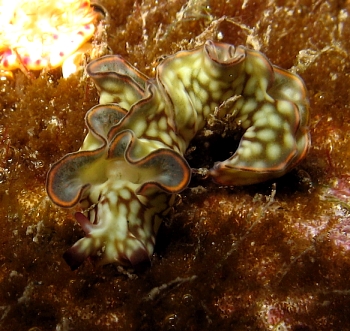
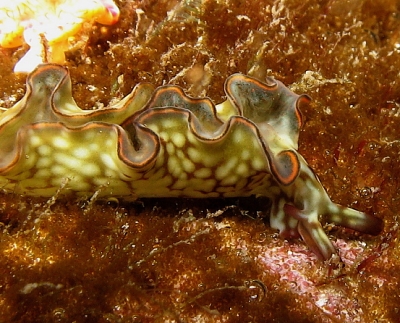
Dear Bill,
I found this Elysia rufescens on algae which it seems to be eating. A guest seems to be a juvenile of Hexabranchus sanguineus.
Can you confirm if it is really feeding?
Locality: Etang-Salé Permanent pool, 20 cm, Reunion Island, Indian Ocean, 30 january 2007, over tide at ten. Length: 40 mm. Photographer: Hugues Flodrops
Best regards and many thanks for your interesting forum.
Hugues
hugues.flodrops@wanadoo.fr
Flodrops,H., 2007 (Jun 18) Elysia rufescens feeding. [Message in] Sea Slug Forum. Australian Museum, Sydney. Available from http://www.seaslugforum.net/find/19384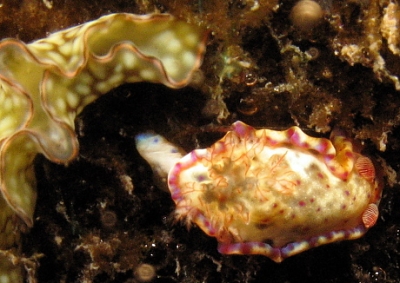
Dear Hugues,
I can't be sure it is feeding in your photos, but Bryopsis, which it is reported to feed on, is often present as fine green filaments which are hard to see individually. I have included a close-up alongside of the 'intruder' [top ;left of upper photos] you asked about, which is indeed a juvenile Hexabranchus.
Best wishes,
Bill Rudman
Elysia rufescens? from sthn Queensland
March 13, 2007
From: Eva McClure
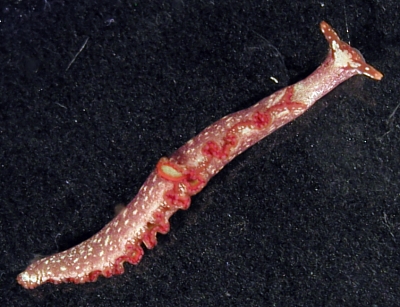
I am an Honours student at the University of Queensland conducting a study on nudibranchs. This specimen was collected (by someone other than myself) off Stradbroke Island. I was hoping that someone may be able to assist me in its identification?
Locality: Stradbroke Island, unknown, Queensland, Australia, Pacific Ocean, 05 March 2007, rocky reef,. Length: 30mm. Photographer: Eva McClure.
Many Thanks,
Eva.
s4074740@student.uq.edu.au
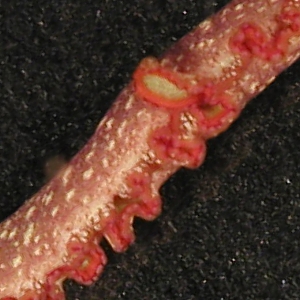
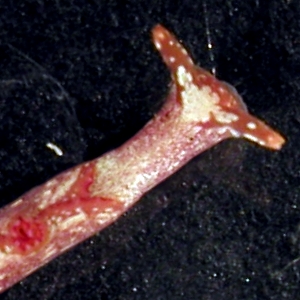
Dear Eva,
I would be interested to know what your Honours project is about. Who knows? - someone may be able to help you. This animal is not a nudibranch, but a sacoglossan sea slug. I suspect it is a reddish form of Elysia rufescens, but would be interested to know whether anyone else has seen a colour form like this, or thinks it is a different species.
Best wishes,
Bill Rudman
Re: Second record of Elysia rufescens from Reunion
January 10, 2007
From: Skip Pierce
Concerning message #19113:
Hi Bill-Happy New Year.
Never had the good fortune to visit the Indian Ocean, but in Hawaii, at least, E. rufescens eats Bryopsis pennata and, from limited collecting experience, is rarely found very far away from it. We have found Bryopsis plastids in the digestive cells of E. rufescens (not published). however, although they retain plastids - I think they are not very good at it. Notice the color of the slug in these pictures is brownish, rather than green. Again from limited experience with them, that is pretty standard. Finally, the external morphology between these and the Hawaiians seems very similar.
Skip
pierce@cas.usf.edu
Pierce, S. K., 2007 (Jan 10) Re: Second record of Elysia rufescens from Reunion. [Message in] Sea Slug Forum. Australian Museum, Sydney. Available from http://www.seaslugforum.net/find/19186Thanks Skip,
Bill Rudman
Second record of Elysia rufescens from Reunion Id
January 9, 2007
From: Hugues Flodrops
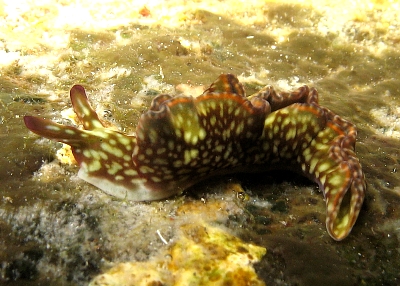
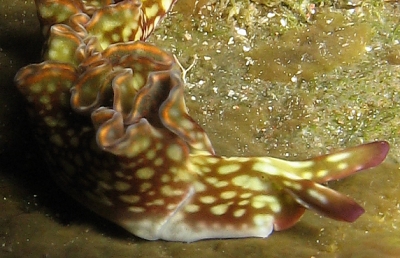
Dear Bill,
2007's greetings.
I found a new specimen of Elysia rufescens, 25 kms of distance from the first three years ago [message #16935]. This new record confirms the presence of Elysia rufescens from the western side of the Indian Ocean.
Locality: Etang-Salé, 0,5 metre, Reunion, Indian Ocean, 27 December 2006. Length: 50 mm. Photographer: Hugues Flodrops.
Best regard and Happy New Year to everyone.
Hugues.
hugues.flodrops@wanadoo.fr
Flodrops,H., 2007 (Jan 9) Second record of Elysia rufescens from Reunion Id. [Message in] Sea Slug Forum. Australian Museum, Sydney. Available from http://www.seaslugforum.net/find/19113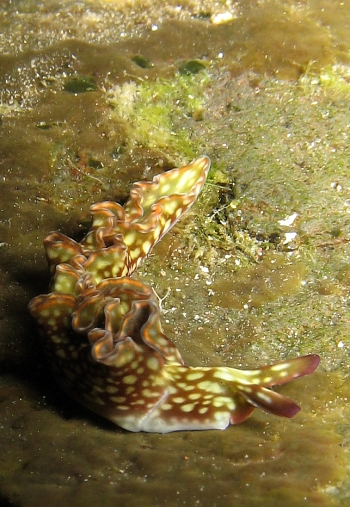
Dear Hugues,
Thanks for the record and the nice photos. It seems to be on a filamentous green algae, perhaps Boodlea or Bryopsis, which could be its food. It has previously been reported to feed on a species of Bryopsis [messages #1189; #6392].
Best wishes,
Bill Rudman
Elysia rufescens from Reunion Island
June 22, 2006
From: Hugues Flodrops
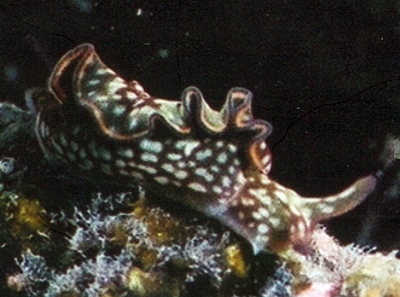
Dear Bill,
I found this Elysia at Reunion Island, Indian Ocean. Is it Elysia ornata or E. rufescens? I ask the same question of Philibert Bidgrain but it seems this is the first record of this species from Indian Ocean. Can you identify this from a single photo?
Locality: Tour de Boucan, 12-15 metres, Reunion Island, Indian Ocean, 3 August 2003, Temp: 24 degrees C. Length: 40 mm. Photographer: Flodrops Hugues.
Best regards,
Hugues.
hugues.flodrops@wanadoo.fr
Flodrops, H, 2006 (Jun 22) Elysia rufescens from Reunion Island. [Message in] Sea Slug Forum. Australian Museum, Sydney. Available from http://www.seaslugforum.net/find/16935Dear Hugues,
This is E. rufescens, which has been rarely reported from the western side of the Indian Ocean. In fact the only record I can find is Terry Gosliner's report of a single animal from the Indian Ocean coast of Sth Africa (Gosliner, 1987).
Best wishes,
Bill Rudman
Elysia rufescens from Saipan, Marianas Ids
November 25, 2005
From: Yuji Fujie
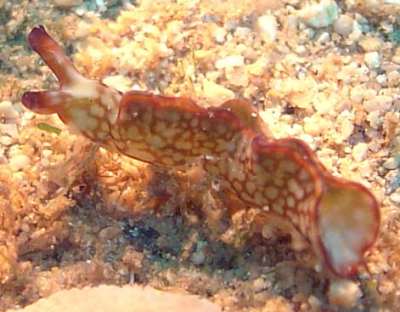
Dear Bill,
I think this is Elysia sp.12. Would you tell me real name ?
Locality: LauLau Beach, Saipan, Marianas Ids, CNMI. Pacific Ocean, Depth: 12 m. Length: 20 mm. 08 November 2005. Photographer: Yuji Fujie
Thanks
Yuji Fujie
dswith@isletwind.com
Yuji Fujie, 2005 (Nov 25) Elysia rufescens from Saipan, Marianas Ids. [Message in] Sea Slug Forum. Australian Museum, Sydney. Available from http://www.seaslugforum.net/find/15352Dear Yuji,
This is Elysia rufescens. Another name given to this animal is E. kushimotoensis. It is intersting seeing these animals in their natural environment. This animal seems to have a very noticeable red reticulate pattern on the parapodia. However when on this shelly background, it belands in quite well with the background substrate, the red network matching the gaps between the shell fragments in the background very well.
Best wishes,
Bill Rudman
Elysia rufescens from Saipan
December 17, 2003
From: Kenji Kobayashi
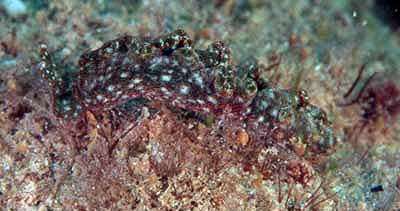
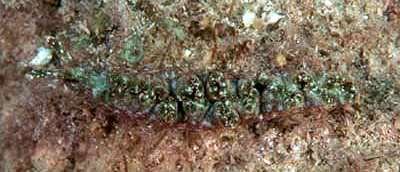
Dear Bill,
Could you identify this please?
The photos are taken in Saipan (Northern Mariana Ids).
Regards
Kenji Kobayashi
squall@gtepacifica.net
Kobayashi, K., 2003 (Dec 17) Elysia rufescens from Saipan. [Message in] Sea Slug Forum. Australian Museum, Sydney. Available from http://www.seaslugforum.net/find/11662Dear Kenji,
It's a bit hard to be sure from the photos, which show how well camouflaged these animals can be, but I think it is probably Elysia rufescens.
Best wishes
Bill Rudman
Re: Elysia rufescens from Myanmar?
April 4, 2003
From: Skip Pierce
Bill-
I agree Mary Jane's Elysia is E. rufescens.
Skip
pierce@chuma1.cas.usf.edu
Pierce, S., 2003 (Apr 4) Re: Elysia rufescens from Myanmar?. [Message in] Sea Slug Forum. Australian Museum, Sydney. Available from http://www.seaslugforum.net/find/9565Thanks Skip,
Bill Rudman
Elysia rufescens? from Myanmar
April 1, 2003
From: Mary Jane Adams
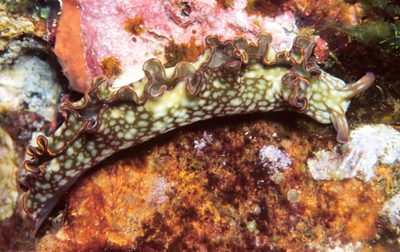
Hi Bill,
I found two species of Elysia crawling on a vertical wall of Black Rock, Mergui Archipelago, Andaman Sea, Myanmar, Feb. 15, 2003. One of them - separate message - looks like a typical Elysia ornata. The other one, which was about 20cm away, is more problematical. Both were about 4 to 5cm long. Depth: 4 meters.
Best regards,
Mary Jane
divepng@yahoo.com
Adams, M.J., 2003 (Apr 1) Elysia rufescens? from Myanmar. [Message in] Sea Slug Forum. Australian Museum, Sydney. Available from http://www.seaslugforum.net/find/9546Dear Mary Jane,
I ma pretty sure this is what I am calling Elysia rufescens. It certainly looks very like the photo on the Forum of Elysia kushimotoensis, which is probably a bright colour form of this species.
Best wishes,
Bill Rudman
Re: Elysia from Flinders Reef, Townsville
January 9, 2003
From: Keven Reed
Concerningr the whereabouts of "Flinder's Reef". Patty Dilworth-Miller was on a live aboard out of Townsville for 9 days when she went to "Flinder's Reef". She didn't give me coordinates.
Thanks for posting,
Keven Reed
kevenreed@earthlink.net
Thanks Keven,
I assumed it was the reef near Townsville, but Australia is a big place so I needed to be sure.
Bill Rudman
Elysia from Flinders Reef, Townsville
January 7, 2003
From: Keven Reed
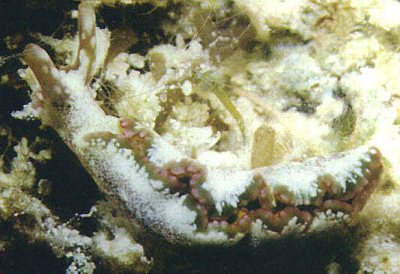
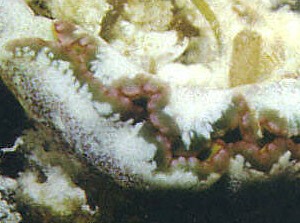
Patty Dilworth took a macro photograph of the attached sacoglossan at Flinder's Reef in Australia and would like to get an id of it (if possible without a dissection). Didn't see it in Wells & Bryce's Western Australia field guide, nor on Bob Bolland's slug site in Okinawa. Robert F. Bolland, PhD, suggested I post the image to you for a look.
Thanks for your time,
Keven Reed,
Frederick, Maryland
kevenreed@earthlink.net
Reed, K., 2003 (Jan 7) Elysia from Flinders Reef, Townsville. [Message in] Sea Slug Forum. Australian Museum, Sydney. Available from http://www.seaslugforum.net/find/8737Dear Keven,
I guess the 'Flinders Reef, Australia' you are talking of is Flinders Reef, 5 kilometres off Cape Moreton, near Townsville, Queensland.
I have never seen an animal looking quite like this before bit it certainly has similarities to some of the photos I have been putting on the Elysia rufescens page. I can't be sure they are all the same species, so perhaps Elysia cf. rufescens, would be a good temporary name.
Best wishes,
Bill Rudman
Culture of Elysia rufescens
September 3, 2002
From: Arcadio
I am interested of growing Elysia rufescens together with Bryopsis in a tank. Is this possible?
Thank you very much
Arcadio
agcastro@pharmamar.com
Dear Arcadio,
In principle it should be possible. The secret will be to keep the algae alive. If you can do that, and can obtain some Elysia rufescens, I see no reason why you coudn't keep them alive. You don't say why you want to grow them. If your plan is to breed them, say for research purposes, you may run into problems. I have no idea whether they have a planktonic larval stage. If they do then that is a fairly difficult stage in the life cycle to deal with in the laboratory.
best wishes,
Bill Rudman
Elysia kushimotoensis and E. rufescens
May 24, 2002
From: Nishina Masayoshi
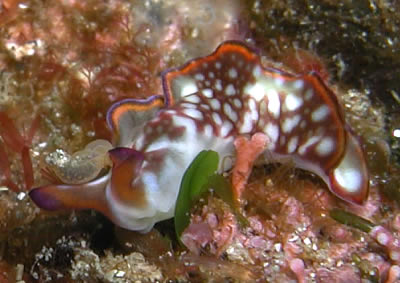
Dear Bill,
I also think that your animal from Christmas Island is E.kushimotoensis.
We find this animal at Hachijo Island, Japan too.
Photo by Rie Nakako,
Date: December 2001
Length: 30mm
Best Regards,
Nishina Masayoshi
nishina@wips.co.jp
Masayoshi, N., 2002 (May 24) Elysia kushimotoensis and E. rufescens. [Message in] Sea Slug Forum. Australian Museum, Sydney. Available from http://www.seaslugforum.net/find/7013Dear Nishina,
Thanks for this interestng photo. is the photo you have sent the usual colour or is this a particularly bright coloured animal?
I am thinking that perhaps like in Hermaea zosterae, smaller animals havea purplish colouration which darkens to black or dark brown as the animal grows in size.
I have checked Baba's description of E. kushimotoensis and it certainly fits the Christmas Island animal:
'Length about 30mm. Ground colour yellowish green, the head brownish, the parapodial surface more darker, almost chocolate brown, and conspicuously maculated with white; the whole body scattered with additional orange-red spots. parapodial margin with a double border, the outer black and the inner orange-red. Rhinophores brownish to the tip.'
From this I think we can be pretty sure that E. kushimotoensis is a synonym of E. rufescens. I would appreciate any comments or photos which might help bridge the gaps between the different colour forms.
• Baba, K (1957) The species of the genus Elysia from Japan. Publications of the Seto Marine Biological Laboratory, 6: 69-74.
Best wishes,
Bill Rudman
Another Samoan Elysia?
May 24, 2002
From: Don Barclay
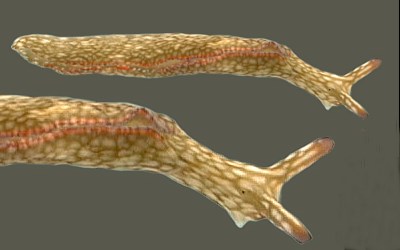
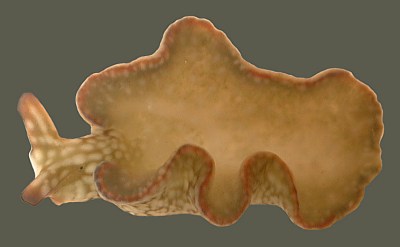
Bill,
Here's another of the common but confusing slugs that I find in American Samoa. I always figured it was a form of Elysia ornata, too, but after examining it closely and watching its behaviour, I think it probably is not. These don't ever have the black marginal line like every other example of E. ornata on your site, and the spotting is a bit different, especially the absence or near absence of black dots. They are much more hesitant to flare their parapodia than E. ornata, and when you find them they are typically folded up and streamlined like Thuridilla vatae, often found in the same areas. While lacking the black marginal markings, they do have the orange line, and the head and rhinophores are very similar to the typical E. ornata. What do you think?
This one was also found on 13 July 2001, around 1800 local, in about one meter of water on an algae-covered boulder, middle of Coconut Point, Nu'uuli, American Samoa. It measured 22mm.
Looking through my new copy of Marine Molluscs of Japan (edited by Okutani) I found a slug that looks like this one. It is on page 764, and is identified as Elysia kushimotoensis.
Fa'afetai,
Don Barclay
n5ols@samoatelco.com
Barclay, D., 2002 (May 24) Another Samoan Elysia?. [Message in] Sea Slug Forum. Australian Museum, Sydney. Available from http://www.seaslugforum.net/find/4822Dear Don,
I'm afraid this is one of the messages that has been 'lost' in the backlog but since I posted the Christmas Island Elysia message, I have had an interesting message from Nishina Masayoshi in Japan, which I will also post today which links E. kushimotoensis with Elysia rufescens. Your animal does indeed look like the photo in Marine Molluscs of Japan, but as I discuss in Nishina's message, it would seem that the odest name for this species is E. rufescens.
Best wishes,
Bill Rudman.
Re: Elysia sp. from Christmas Island
May 20, 2002
From: Skip Pierce
Your animal looks an awful-lot like (a dead) Elysia rufescens that I've collected in Hawaii - but I'm a cell biologist, so beware my identification.
Skip Pierce
Professor and Chair
Dept. of Biology
Univ. of South Florida
pierce@chuma1.cas.usf.edu
Pierce, S., 2002 (May 20) Re: Elysia sp. from Christmas Island. [Message in] Sea Slug Forum. Australian Museum, Sydney. Available from http://www.seaslugforum.net/find/7003Thanks Skip,
Looking at Pease's original illustration and Carlson & Hoff's photo from Guam, which are already on the Forum, this animal from Christmas Is looks midway between them. Thanks for your rapid response - I don't like leaving photos on the 'unidentified pages' as they tend to get ignored. If you would like to contribute a short note to the Forum on your chloroplast symbiosis research and possible gene transfer in elysiids, it would be very welcome.
Best wishes,
Bill Rudman
Re: Elysia sp. from Christmas Island
May 20, 2002
From: Clay & Patty Jo
Dear Bill
Your animal is Elysia rufescens.
Clay & Patty Jo
ccarlson@kuentos.guam.net
Carlson, C. & Hoff, P.J., 2002 (May 20) Re: Elysia sp. from Christmas Island. [Message in] Sea Slug Forum. Australian Museum, Sydney. Available from http://www.seaslugforum.net/find/7009Thanks for the fast response,
Bill Rudman
Elysia sp. from Christmas Island
May 18, 2002
From: W.B. Rudman
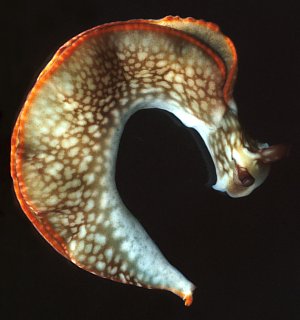
Any clues on the identity of this Elysia? sp. from John Hicks' Christmas Island, Indian Ocean collections would be very welcome.
PHOTO: AM C137595, 32 mm long alive 11 July 1982, in public swimming pool (saltwater) on green algae, Christmas Is., Indian Ocean. Photo: John Hicks
Best wishes,
Bill Rudman
Elysia rufescens - natural products
March 10, 2002
From: Bill Rudman
Some time ago Lucas Cervera inquired about published results from research on E. rufescens. I just came across these references.
• Hamann, M.T. & Scheuer, P.J. (1993). Kahalalide F, a Bioactive Depsipeptide from the Sacoglossan Mollusk Elysia rufescens and the Green Alga Bryopsis sp.. J. Am. Chem. Soc.,115: 5825-5826
• Hamann, M.T., Otto, C.S., Scheuer, P.J., Dunbar, D.C (1996) Kahalalides: Bioactive Peptides from A Marine Mollusk Elysia rufescens and Its Algal Diet Bryopsis sp. J. Org. Chem., 61: 6594-6600.
Researchers at the University of Hawaii have been studying Elysia rufescens which feeds on Bryopsis sp.. It elaborates a series of depsipeptides ranging from a C31 tripeptide to a C75 tridecapeptide, kahalalide F(2). They have discovered that Kahalalide F has promising antitumor and antiviral activity. The new compound is active against solid tumors of the lung and colon and is present, in low concentration, in both Elysia and Bryopsis sp..
Bill Rudman
Rudman, W.B., 2002 (Mar 10) Elysia rufescens - natural products. [Message in] Sea Slug Forum. Australian Museum, Sydney. Available from http://www.seaslugforum.net/find/6392Photos of Elysia rufescens
August 15, 1999
From: C. Carlson & P.J. Hoff
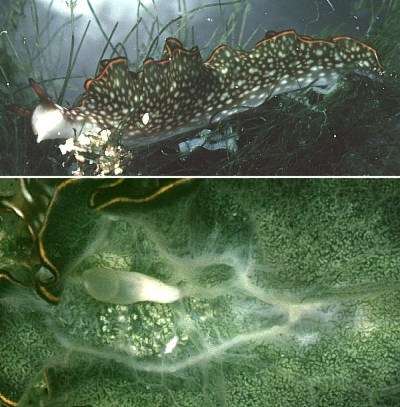
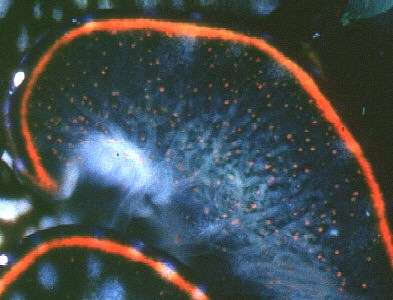
Bill,
Here are some scans of Elysia rufescens you can probably use. Sorry about the glare on the mouth parts on the full animal.
UPPER: 60mm; Guam, Pago Bay, reef flat; 13 July 1984 on Bryopsis pennata
MIDDLE: dorsal view of body behind the head, normally hidden by parapodia showing pericardial bulb and branching blood vessels. The green reticulate pattern, is the finely ramifying ducts of the digestive gland filled with plant tissue, probably chloroplasts. Guam, Agat, Ga'an Point, reef flat; 3 April 1989 on Bryopsis pennata
LOWER: Variety showing red spots on interior of parapodia as described by Pease. About 30mm long; Guam, Pago Bay, reef flat; 1 April 1971 on Caulerpa racemosa.
The first time we found E. rufescens it was on
You are going to owe me a couple of litres of martinis if I ever make it to Sydney.
Clay.
clay.carlson@kuentos.guam.net
Carlson, C. & Hoff, P.J., 1999 (Aug 15) Photos of Elysia rufescens. [Message in] Sea Slug Forum. Australian Museum, Sydney. Available from http://www.seaslugforum.net/find/1189Dear Clay & Patty Jo,
Thanks for the great photos. If you ever make it to this end of the Pacific, I am sure I can arrange an appropriate reward.
Best wishes,
Bill Rudman.
Natural products of Elysia rufescens
August 13, 1999
From: Juan Lucas Cervera
Dear Bill:
Thank you very much for your information and nice pictures.
Some days ago, I have known through other colleagues that replied to my question, that this species feeds upon Bryopsis sp., among other algae. I also knew that some natural products potentially very active from a pharmacologically point of view have been discovered from this slug and also from its Bryopsis prey (Hamann & Scheuer, 1993, Journal of American Chemical Society 115:5825-5826 ). In this paper, the authors stated that other new discovered products were in the process of publication. Does anyone know if the description of those products are finally published?
Thank you very much.
Juan Lucas Cervera.
lucas.cervera@uca.es
Does anyone have a photo of the animal?
Bill Rudman.
Elysia rufescens from Hawaii
August 10, 1999
From: Juan Lucas Cervera
Dear Bill:
There are one species of Elysia from Hawaii which exact name I don't know, E. rubescens or rubesfens, or some thing like this. Could you supply me more information about it? Thanks.
Lucas.
lucas.cervera@uca.es
Cervera, J.L., 1999 (Aug 10) Elysia rufescens from Hawaii. [Message in] Sea Slug Forum. Australian Museum, Sydney. Available from http://www.seaslugforum.net/find/1165
Dear Lucas,
I guess you mean Pterogasteron rufescens Pease, 1871. I have scanned a copy of the figs Plate 22, figs 1a,b,c, alongside. It was 1.25 inches long. Found at Tahiti.
Alison Kay identifies a species from Hawaii as Elysia rufescens (Pease 1871) and describes it as:
"11mm, dark red maculated with spots of creamy green which impart a reticulated appearance to the animal, parapodia margined in orange, rhinophores dark red tipped with purple".
References:
* Kay, E.A. (1979)- Hawaiian Marine Shells, Bishop Museum Special Publication 64(4). Bishop Museum Press: Honolulu. p454.
* Pease, W.H. (1871). Descriptions of Nudibranchiate Mollusca inhabiting Polynesia. American Journal of Conchology,6(4): 299-305.
